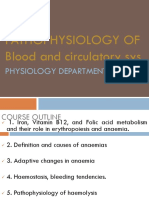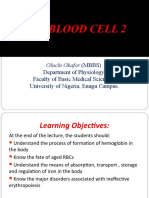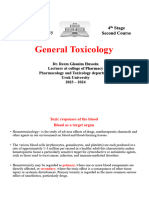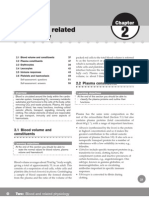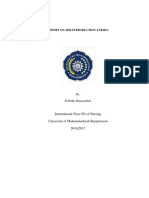Problem Set 9: Hematopoeisis: Please Refer To The Diagram
Problem Set 9: Hematopoeisis: Please Refer To The Diagram
Uploaded by
johnjiaoCopyright:
Available Formats
Problem Set 9: Hematopoeisis: Please Refer To The Diagram
Problem Set 9: Hematopoeisis: Please Refer To The Diagram
Uploaded by
johnjiaoOriginal Title
Copyright
Available Formats
Share this document
Did you find this document useful?
Is this content inappropriate?
Copyright:
Available Formats
Problem Set 9: Hematopoeisis: Please Refer To The Diagram
Problem Set 9: Hematopoeisis: Please Refer To The Diagram
Uploaded by
johnjiaoCopyright:
Available Formats
PROBLEM SET 9: HEMATOPOEISIS 1.
Give the sequence of events how a pluripotent hematopoietic stem cell gives rise to the different blood cells.
Hematopoietic stem cells give rise to Myeloid and Lymphoid lineages The Common Myeloid Progenitor cells give rise to erythroid progenitor cells and myeloid cells and some dendritic cells. o Megakaryocyte o Erythrocyte o Mast Cell o Myeloblast The Common Lymphoid Progenitor cells give rise to B lymphocytes, T lymphocytes, killer cells, and some dendritic cells. o Small Lymphocyte white blood cells formed in the bodys lymphoid tissue. The nucleus is round or ovoid with coarse irregularity clumped chromatin while the cytoplasm is typically pale blue with azurophilic granules. Most cells are classified as either T or B; those cannot be classified are called null cells. B lymphocyte Lymphoid cells concerned with humoral immunity. Plasma Cell specialized forms of antibody-producing Blymphocytes. They synthesize and secrete immunoglobulin. T lymphocyte Lymphocytes responsible for cell-mediated immunity. o Natural Killer cell responsible for the cytotoxicity of a variety of tumor cells without prior immunization. *please refer to the diagram
4. Explain how anemia develops in the following: a) patients with chronic renal failure b) strict vegans A)This defect in red blood cell production is largely explained by the inability of the failing kidneys to secrete the hormone erythropoietin. This hormone is a necessary stimulus for normal bone marrow to produce red blood cells. In addition, other factors associated with renal failure, including the accumulation of so-called uremic toxins, may play a role in depressing bone marrow function. Excess stores of aluminum may accumulate in the bone marrow of long term dialysis patients and can contribute to anemia as well. Blood loss and red blood cell destruction also frequently contribute to the anemia in patients with renal failure. Platelets, which are small constituents of blood which aid in blood clotting, do not work normally in uremia. The defective blood clotting seen in uremia makes bleeding more common. Rapid bleedingfrom an ulcer in the gastrointestinal tract, for examplecauses a rapid decrease in the hematocrit and is a medical emergency. Very slow loss of blood can also cause anemia by depleting the bodys stores of iron, which the bone marrow uses to produce blood cells. Excessive destruction of red blood cells is also seen in advanced renal failure. Normally, red blood cells survive for about four months before being destroyed. This life span is reduced in renal failure, probably because of chemical effects of uremia and decreased flexibility of the red blood cells. This hemolysis is usually mild and a
person with a normal bone marrow could easily compensate for it by increasing red blood cell production. However, in renal failure, the bone marrows capacity to compensate is diminished. B) Strict vegetarians. Vegetarians who avoid all animal products may have a slightly higher risk for deficiencies in iron and some B vitamins. Although dried beans and green vegetables often contain iron, it is less easily absorbed from plants than from meat. 5. Explain the consequence of living in a high altitude area such as Baguio on erythropoiesis. Give one example of a pathologic condition that can give rise to the same phenomenon above. Increasing hemoglobin concentration is a response long considered to be a beneficial adaptation, whereby an increase in the oxygen-carrying capacity of the blood compensates for the arterial hypoxemia of altitude. Without such an adaptation, maintenance of the arterial oxygen delivery to the tissues would require an increased cardiac output, an energy-intensive response. As one goes to high altitude, plasma volume immediately begins to contract, quickly raising the hemoglobin concentration. As one remains at altitude, erythropoiesis increases both the hemoglobin concentration in the blood and the total amount in the body. Thus, by different mechanisms, both acute and chronic hypoxemia serve to increase blood hemoglobin concentration. However, at some point, the increase in hemoglobin concentration ceases to be a benefit and becomes a curse. That is, some individuals lose their ventilatory acclimatization to hypoxia after a decades-long residence at high altitude. They cease to hyperventilate, suffer central depression of respiration particularly at night, and develop severe hypoxemia, which over time stimulates excessive polycythemia. With hemoglobin concentrations usually above 23 g/100 ml, these individuals develop a potentially fatal syndrome called chronic mountain sickness.
7. Explain the consequences of congenital spherocytosis, a hereditary disorder most often caused by defective structural or peripheral proteins.
Congenital spherocytosis is caused by a defect of erythrocyte membrane proteins. These proteins are needed for the maintenance of the biconcave structure of erythrocytes. The most commonly defective integrating protein is ankyrin,which is responsible for the binding of spectrin. A defect brings up cytoskeletal instabilities in erythrocytes. These affected erythrocytes will then be destroyed by the spleen, which targets abnormally shaped erythrocytes. As this goes, infants may have yellowing of skin and eyes (jaundice) and pale coloring (pallor). It may also lead to anemia, fatigue or weakness, irritability, and shortness of breath.
You might also like
- Critical Thinking & Logic Mastery 3 Books in 1 - How To Make Smarter Decisions, Conquer Logical100% (1)Critical Thinking & Logic Mastery 3 Books in 1 - How To Make Smarter Decisions, Conquer Logical380 pages
- SickLeaveCertificate With and Without Diagnosis 20240227 144109No ratings yetSickLeaveCertificate With and Without Diagnosis 20240227 1441092 pages
- Pathophysiology of Blood and Circulatory Sys: Physiology DepartmentNo ratings yetPathophysiology of Blood and Circulatory Sys: Physiology Department73 pages
- Erythrocyte Life Cycle: PathophysiologyNo ratings yetErythrocyte Life Cycle: Pathophysiology15 pages
- Blood: - Enzymes, E.G. Certain Clotting FactorsNo ratings yetBlood: - Enzymes, E.G. Certain Clotting Factors14 pages
- Lec.5 & Lec.6 Toxic Response of the Blood.pdf دمجNo ratings yetLec.5 & Lec.6 Toxic Response of the Blood.pdf دمج15 pages
- DR - Zahraa N. Alqaisy HematopathologistNo ratings yetDR - Zahraa N. Alqaisy Hematopathologist23 pages
- Basic and Clinical Pharmacology 14th Edition 2018 - Copy - RemovedNo ratings yetBasic and Clinical Pharmacology 14th Edition 2018 - Copy - Removed17 pages
- Salinan Terjemahan 307211717 Laporan Pendahuluan AnemiaNo ratings yetSalinan Terjemahan 307211717 Laporan Pendahuluan Anemia16 pages
- Hematopoeitic System: Nsoh Fofang Mia Bios 2021 Edited by Laouna Fru Supervised by DR DimitriNo ratings yetHematopoeitic System: Nsoh Fofang Mia Bios 2021 Edited by Laouna Fru Supervised by DR Dimitri66 pages
- IT 1 - LIN Folic Acid & B12 Deficiency Anemia, Thalassemia & Hemoglobinopathia (BIOKIMIA)No ratings yetIT 1 - LIN Folic Acid & B12 Deficiency Anemia, Thalassemia & Hemoglobinopathia (BIOKIMIA)92 pages
- Types Of Hemolytic Anemia, A Simple Guide To The Condition, Treatment And Related ConditionsFrom EverandTypes Of Hemolytic Anemia, A Simple Guide To The Condition, Treatment And Related ConditionsNo ratings yet
- Paroxysmal Nocturnal Hemoglobinuria, A Simple Guide To The Condition, Diagnosis, Treatment And Related ConditionsFrom EverandParoxysmal Nocturnal Hemoglobinuria, A Simple Guide To The Condition, Diagnosis, Treatment And Related ConditionsNo ratings yet
- Manual For Victorian Class B Cemetery TrustsNo ratings yetManual For Victorian Class B Cemetery Trusts223 pages
- Hydrostatic Pressure and Colloid Osmotic Pressure QuestionsNo ratings yetHydrostatic Pressure and Colloid Osmotic Pressure Questions2 pages
- ABRAVAS 2 de 9 - Divers 1999 - Reptile EndosNo ratings yetABRAVAS 2 de 9 - Divers 1999 - Reptile Endos8 pages
- Menopause Impacts Human Brain Structure, Connectivity, Energy Metabolism, and Amyloid-Beta DepositionNo ratings yetMenopause Impacts Human Brain Structure, Connectivity, Energy Metabolism, and Amyloid-Beta Deposition16 pages
- Multidimensional Cognitive Attentional Syndrome ScaleNo ratings yetMultidimensional Cognitive Attentional Syndrome Scale2 pages
- BIO 102 Introductory Biology: Phylum NematodaNo ratings yetBIO 102 Introductory Biology: Phylum Nematoda11 pages
- Adare_A New Framework for Identifying Nitrosamine Risks_13062024No ratings yetAdare_A New Framework for Identifying Nitrosamine Risks_130620244 pages
- 7 Lessons For Leading in Crisis LeadersNo ratings yet7 Lessons For Leading in Crisis Leaders11 pages
- Infectious Diseases of The Lungs: Viral InfectionsNo ratings yetInfectious Diseases of The Lungs: Viral Infections46 pages

















